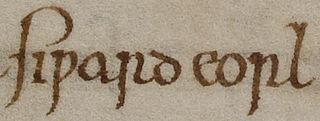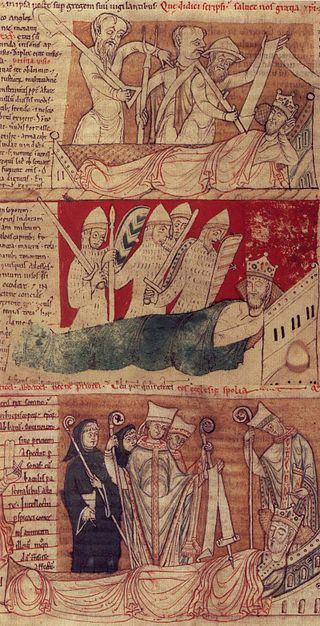Related Research Articles
Florence of Worcester was a monk of Worcester, who played some part in the production of the Chronicon ex chronicis, a Latin world chronicle which begins with the creation and ends in 1140.
Nennius – or Nemnius or Nemnivus – was a Welsh monk of the 9th century. He has traditionally been attributed with the authorship of the Historia Brittonum, based on the prologue affixed to that work. This attribution is widely considered a secondary (10th-century) tradition.
William of Poitiers was a Norman priest who served as the chaplain of Duke William II of Normandy, for whom he chronicled the Norman conquest of England in his Gesta Willelmi ducis Normannorum et regis Anglorum. He had trained as a soldier before taking holy orders.
Historians in England during the Middle Ages helped to lay the groundwork for modern historical historiography, providing vital accounts of the early history of England, Wales and Normandy, its cultures, and revelations about the historians themselves.
William Rishanger, nicknamed "Chronigraphus", was an English annalist and Benedictine monk of St. Albans. Rishanger quite likely wrote the Opus Chronicorum, a continuation from 1259 of Matthew Paris's Chronicle. In effect it is a history of his own times from 1259 to 1307, a spirited and trustworthy account, albeit in parts not original. He wrote a history of the reign of Edward I of England, and a work on the Barons' War; and was probably the continuator of Gesta Abbatum Monasterii Sancti Albani.

Siward or Sigurd was an important earl of 11th-century northern England. The Old Norse nickname Digri and its Latin translation Grossus are given to him by near-contemporary texts. It is possible Siward may have been of Scandinavian or Anglo-Scandinavian origin, perhaps a relative of Earl Ulf, although this is speculative. He emerged as a regional strongman in England during the reign of Cnut. Cnut was a Scandinavian ruler who conquered most of England in the 1010s, and Siward was one of many Scandinavians who came to England in the aftermath, rising to become sub-ruler of most of northern England. From 1033 at the latest, he was in control of southern Northumbria, present-day Yorkshire, governing as earl on Cnut's behalf.
Nothhelm was a medieval Anglo-Saxon Archbishop of Canterbury. A correspondent of both Bede and Boniface, it was Nothhelm who gathered materials from Canterbury for Bede's historical works. After his appointment to the archbishopric in 735, he attended to ecclesiastical matters, including holding church councils. Although later antiquaries felt that Nothhelm was the author of a number of works, later research has shown them to be authored by others. After his death he was considered a saint.

John of Worcester was an English monk and chronicler who worked at Worcester Priory. He is now usually held to be the author of the Chronicon ex Chronicis.
The Historia Regum is a historical compilation attributed to Symeon of Durham, which presents material going from the death of Bede until 1129. It survives only in one manuscript compiled in Yorkshire in the mid-to-late 12th century, though the material is earlier. It is an often-used source for medieval English and Northumbrian history. The first five sections are now attributed to Byrhtferth of Ramsey.
De obsessione Dunelmi is an historical work written in the north of England during the Anglo-Norman period, almost certainly at Durham, and probably in either the late 11th or early 12th century.

The Liber Eliensis is a 12th-century English chronicle and history, written in Latin. Composed in three books, it was written at Ely Abbey on the island of Ely in the fenlands of eastern Cambridgeshire. Ely Abbey became the cathedral of a newly formed bishopric in 1109. Traditionally the author of the anonymous work has been given as Richard or Thomas, two monks at Ely, one of whom, Richard, has been identified with an official of the monastery, but some historians hold that neither Richard nor Thomas was the author.
Relatio de Standardo, or De bello standardii, is a text composed probably in 1153 or 1154 by the Cistercian monk Aelred of Rievaulx, describing the Battle of the Standard, fought near Northallerton in 1138 between David I, King of Scotland, and a Norman army fighting in support of King Stephen of England.
Æthelwig was an Abbot of Evesham before and during the Norman Conquest of England. Born sometime around 1010 or 1015, he was elected abbot in 1058. Known for his legal expertise, he administered estates for Ealdred, the Bishop of Worcester prior to his election as abbot. After his election, he appears to have acted as Ealdred's deputy, and was considered as a possible successor when Ealdred was elected Archbishop of York. Æthelwig worked during his abbacy to recover estates that had been lost to Evesham, as well as acquiring more estates.
Hemming was a monk, author and compiler in medieval England from around the time of the Norman conquest of England. He was a senior brother at Worcester Cathedral Priory, and his significance derives from the monastic cartulary attributed to him.
Antonia Gransden, English historian and medievalist, was Reader in Medieval History at the University of Nottingham. She was author of works in medieval historiography, including the massive two-volume study Historical Writing in England, covering a thousand years of historical writing from the 6th to the 16th century.

The Vita Sancti Wilfrithi or Life of St Wilfrid is an early 8th-century hagiographic text recounting the life of the Northumbrian bishop, Wilfrid. Although a hagiography, it has few miracles, while its main concerns are with the politics of the Northumbrian church and the history of the monasteries of Ripon and Hexham. It is one of a collection of historical sources from the late 7th- and early 8th-centuries, along with the anonymous Vita Sancti Cuthberti, the works of Bede and Adomnán's Vita Sancti Columbae, that detail the Christianisation of Great Britain and make the period the best documented period in English history before the age of Alfred the Great.
Thomas of Marlborough was a medieval English monk and writer. He became abbot of Evesham Abbey in 1230.
The Historia Ecclesie Abbendonensis or History of the Church of Abingdon was a medieval chronicle written at Abingdon Abbey in England in the 12th century. The Abbey was historically in the county of Berkshire, but since 1974 has been in the county of Oxfordshire.
Tatberht was an eighth century Anglo-Saxon saint, abbot and contemporary of Bede.
The Brut Chronicle, also known as the Prose Brut, is the collective name of a number of medieval chronicles of the history of England. The original Prose Brut was written in Anglo-Norman; it was subsequently translated into Latin and English.
References
- Gransden, Antonia (1997), Historical Writing in England, vol. 1, c. 550—c.1307, London: Routledge, ISBN 0-415-15124-4